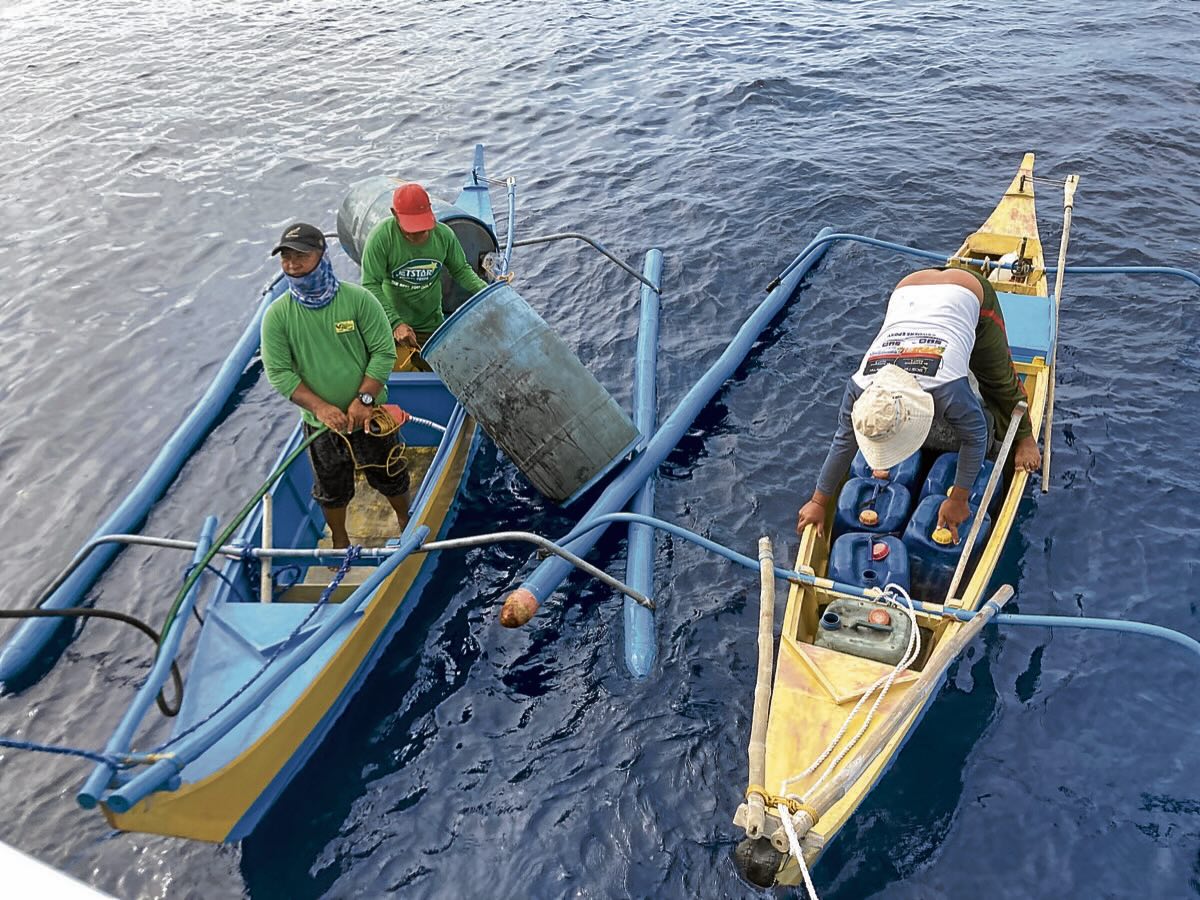China’s harassment takes toll on PH fishers

ABOARD BRP DATU SANDAY, WEST PHILIPPINE SEA—Not only Philippine vessels but also Filipino fishermen were being driven away by Chinese ships over the last few weeks at Escoda (Sabina) Shoal, the new flashpoint in the West Philippine Sea.
Fisherman Sofronio Lopez told reporters onboard this ship on Aug. 25 that China Coast Guard (CCG) and Chinese militia ships drove them away about 24 kilometers from Escoda Shoal at 10:30 p.m. the night before.
Lopez said their motorized bancas were no match to the size of the vessels which “encircled us,” as their crewmen, speaking through megaphones “drove [us] away.”
“We could not do anything because our boats are made only of wood, so we just left the area,” he said. “We were traumatized.”
Lopez said he and 15 crewmen onboard fishing boat FB Jamaezel 3 traveled four days to Escoda from Balayan town in Batangas province.
But they left the vicinity of the shoal on Saturday night without any catch because, amid the Chinese harassment, they were not able to reach the “payao” or “floating aggregate devices” used to attract the fish.
“The situation for us fishermen here is very difficult because we no longer have any area to fish,” he said.
Escoda is only about 139 km off Palawan province and well within the country’s 370-km exclusive economic zone.
The situation in the West Philippine Sea is “getting worse,” Lopez said. “We have children who go to school but we don’t know where to get the money for their education.”
He said every incident of Chinese ships getting in the way of their livelihood is an income loss for them.
“It’s very painful to think that our children will slowly die of hunger,” Lopez said.

Fishing costs
Fisherman Jasson Pagilagan and his crew, also from Balayan, said the Chinese vessels were “getting closer” to our shores.
During their sail to Escoda also last week, Chinese ships shadowed their fishing boat Aaron Justin even as Palawan’s mountains were still within viewing distance.
He noted the increasing presence of those vessels, saying they were “not [a] comfortable” sight. “We are worried about what they might do to us.”
“It’s like we are intruding into their territory but this is ours,” he said.
According to Pagilagan, he and the crew lose about P50,000 each time they are unable to fish because of harassment by the Chinese.
He said they invested about P400,000 to P500,000 for their fishing ventures in the West Philippine Sea. Lopez also cited those figures when asked about the costs entailed for the FB Jamaezel 3 crew.
Both crews had just been given 2,000 liters of diesel each as part of the resupply mission of the BRP Datu Sanday, a vessel of the Bureau of Fisheries and Aquatic Resources (BFAR).
On Aug. 26, BFAR also provided about that much fuel to the crew of FB Gem-Vir 2, a “sister boat” of Gem-Vir 1 which was rammed by a Chinese vessel in 2019.
The Gem-Vir 2, which is from San Jose, Occidental Mindoro, was fishing near Palawan that day because of the threat of Chinese vessels in other parts of the West Philippine Sea.
Jean Ensigne, captain of that boat, said they no longer attempt to enter Escoda Shoal. “It is scary there. Nothing will happen there. We will just be driven away,” he said.
Small catch
Even fishermen from Pagasa Island, which is part of the municipality of Kalayaan in Palawan, find their livelihood threatened by the Chinese.
Larry Hugo, president of the Pag-asa Island Fisherfolk Association, said their daily catch had decreased from 50 kilos to just 20 kilos.
He recalled that in 2021, a CCG ship blasted its horn and blocked his fishing vessel as it approached one of the sandbars off Pag-asa.
“We are like thieves in our own territory,” Hugo said in an interview inside his small home as he recounted how the Chinese vessels chased their fishing boats in their own traditional fishing grounds.
He said he could go fishing as far as Zamora (Subi) Reef when China had not yet militarized that area.
China has since turned Zamora, which is only about 26 km southwest of Pag-asa Island, into a military base with a runway, lighthouses, communication facilities, hangars and multistory buildings.
Ador Sacamay, 28, who goes fishing when he is not on duty at the National Power Corp. office in Pag-asa, said his catch was down to 5 kilos, adding that this could also be due to cyanide fishing by Chinese and Vietnamese vessels.
He said he recently saw many dead fish floating on the vicinity waters of Pag-asa.
But marine scientist Jonathan Anticamara of the University of the Philippines Institute of Biology said the waters of Pag-asa and other maritime areas face another threat—climate change—as he cited the degraded state of corals near Pag-asa’s sandbars, to cite just one area.
“The death of corals is extensive—from Zambales to Escoda. Extensively dead. If the death of corals is like that, it cannot be attributed to a localized disturbance such as the presence of a ship. One possible reason is climate change,” Anticamara told reporters on Aug. 22.
Common sight
Yet the predominant threat to fishermen in the West Philippine Sea remains China.
On Aug. 21, as many as 14 Chinese militia vessels were seen from Pag-asa. They were joined by a warship and a CCG vessel.
The Inquirer joined BFAR’s maritime patrol that week near the sandbars of this island barangay.
A Chinese militia vessel with bow No. 00118 made dangerous maneuvers about 50 meters close and blocked BFAR’s BRP Taradapit as it approached Sandy Cay 2, which is about 3.7 km from Pag-asa.
For the villagers, the presence of Chinese vessels has already become a common sight, to their dismay.





















